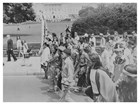From 1968 to 1978, American Indian activists engaged in a series of marches to the nation's capital to demand rights for their tribes and communities. Foremost among their demands was that the United States honor its treaties with Indigenous nations. These movements laid the foundation for the ongoing struggle for Native rights in the United States. Read on to learn more about this important chapter in Native American history.
-
Article 1: The Struggle for Sovereignty: Series Overview

Since the founding of the United States, Native American leaders, delegates, and activists have traveled to the nation’s capital to protest violations of their homelands and to assert their sovereign rights as independent nations. These articles focus on a series of major protests from 1968-1978, in which Native peoples from across the United States converged on Washington, D.C. to bring their issues to the nation’s capital. Read more
-
Article 2: Native Americans in the Poor People's Campaign

During the Poor People’s Campaign, Native peoples from reservations and cities marched arm-in-arm with African Americans, Latinos, and white Appalachians. But for Native peoples, crushing poverty was unique in that it was the result of America’s territorial expansion, broken treaties, and continuing colonialism. Instead of civil rights, American Indian activists demanded sovereignty: the right to control their own land and resources. Read more
-
Article 3: The Trail of Broken Treaties, 1972

In 1972, American Indian activists traveled to Washington in a demonstration called the Trail of Broken Treaties to present their demands for indigenous rights. The demonstration ended in the week-long occupation of the Bureau of Indian Affairs by American Indian activists. Although the occupation ultimately overshadowed the even the activists outlined in a Twenty-Point Position Paper that established an agenda for the Native American rights struggle in the years to come. Read more
-
Article 4: The Trail of Self-Determination, 1976

In 1976, the United States celebrated 200 years of independence. But the Bicentennial carried a very different meaning for American Indian communities still engaged in a struggle for self-determination. Four years after American Indian demonstrators occupied the Bureau of Indian Affairs, they once again embarked on a cross-country caravan to demand Native rights, carrying with them the Twenty Points from the Trail of Broken Treaties. Read more
-
Article 5: The Longest Walk, 1978

The Longest Walk of 1978 was conceived as both a spiritual and political demonstration. Adding to the general call for sovereignty behind the previous demonstrations, the Longest Walk protested eleven pieces of legislation then being considered by Congress that would violate various treaty rights, particularly concerning Indian land, fishing, and mineral rights. The demonstrations were also an opportunity to educate non-Indians about Indian cultural and spiritual life. Read more
